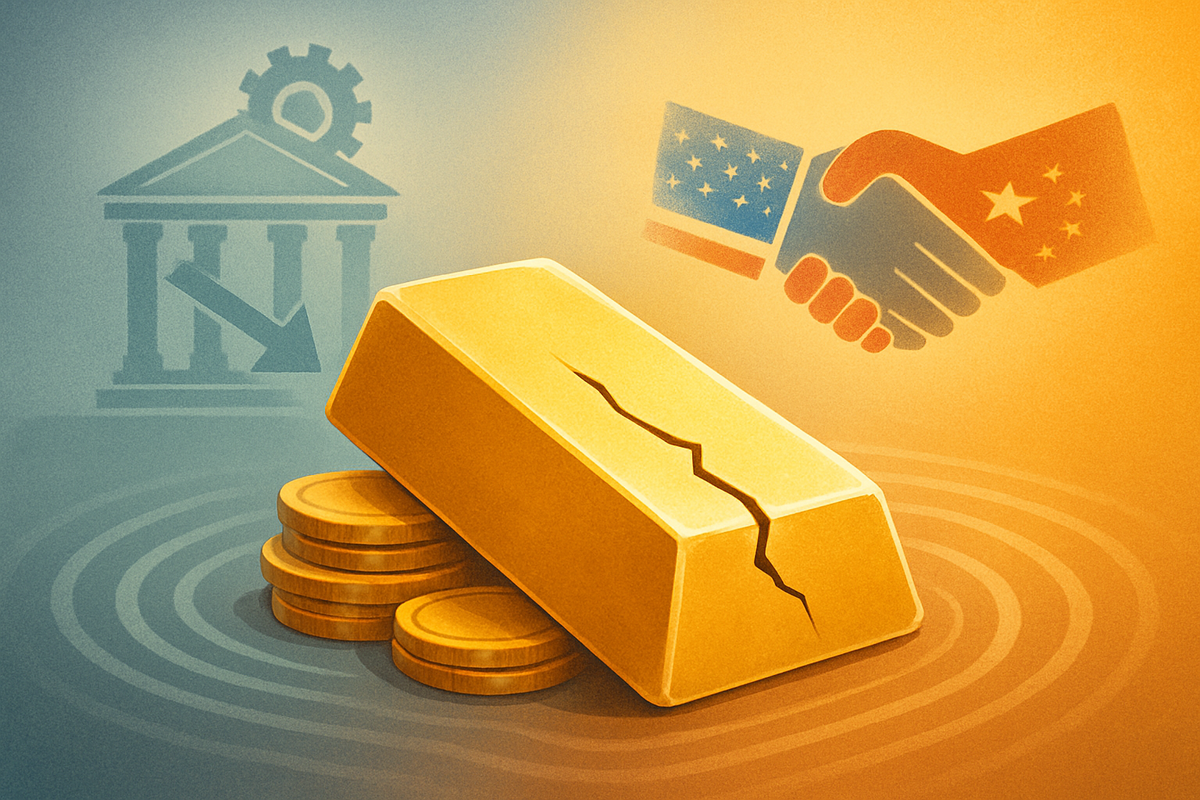
New York, NY – October 30, 2025 – Gold prices have experienced a significant downturn, falling below the critical $4,000 per ounce threshold, marking one of the sharpest corrections in over a decade. This immediate market reaction stems from a potent combination of the Federal Reserve's latest interest rate decision and a newly forged trade truce between the United States and China. Investors are actively reassessing their portfolios, shifting away from the traditional safe-haven allure of gold as global economic anxieties appear to recede.
The precious metal, which had seen an almost 50% surge year-to-date, reaching an all-time high of $4,381.58 earlier in October, is now facing intense selling pressure. This recalibration highlights the delicate balance between monetary policy expectations and geopolitical stability, directly impacting gold's role as a store of value in uncertain times. The current environment suggests a notable pivot in market sentiment, moving from a fear-driven allocation to a more risk-on approach.
A Confluence of Factors Reshapes Gold's Trajectory
The recent decline in gold prices is a direct consequence of two pivotal developments. Firstly, the Federal Reserve, at its October 2025 meeting, announced a 25-basis-point cut to the federal funds rate, bringing the target range to 3.75%-4.00%. While rate cuts typically bolster gold by reducing the opportunity cost of holding the non-yielding asset, Fed Chair Jerome Powell's accompanying remarks tempered enthusiasm. Powell downplayed the likelihood of another cut in December, citing internal disagreements and a lack of complete federal data due to a government shutdown. This cautious, somewhat hawkish tone created a mixed signal, preventing gold from fully capitalizing on the rate reduction and contributing to selling pressure.
Concurrently, a groundbreaking "trade truce" was announced between U.S. President Donald Trump and Chinese President Xi Jinping following their meeting in Busan, South Korea. This agreement has significantly de-escalated global trade tensions that had plagued markets for months. Key elements of the deal include the cancellation of President Trump's previous threat of a 100% tariff increase on Chinese goods, an immediate reduction of existing tariffs from 57% to 47%, China's commitment to substantial purchases of U.S. agricultural products, and a delay in new export restrictions on rare earth minerals. The resolution of these trade frictions has fostered a pronounced "risk-on" sentiment, leading investors to divest from safe-haven assets like gold and reallocate capital into riskier, higher-growth assets such as equities, which saw immediate surges following the announcement.
The timeline leading to this moment has been characterized by persistent trade friction between the US and China, which consistently fueled demand for gold throughout 2024 and early 2025. Each escalation, from tariff threats to supply chain disruptions, pushed gold to new highs as investors sought refuge from economic uncertainty. Simultaneously, the Federal Reserve's monetary policy path, oscillating between hawkish stances to combat inflation and dovish shifts to support employment, has kept markets on edge. The recent rate cut, while seemingly dovish, was overshadowed by the trade truce, creating a powerful counter-narrative for gold. Key players involved are, of course, the Federal Reserve, led by Chair Powell, and the governments of the United States and China. Their policy decisions and diplomatic efforts have directly shaped the macroeconomic landscape, dictating investor behavior and, consequently, gold's market performance. Initial market reactions have seen a broad shift towards optimism, with global equity markets rallying, indicating a renewed appetite for risk and a diminished perceived need for traditional safe havens.
Companies Navigating a Shifting Landscape
The recalibration of gold prices will undoubtedly create winners and losers across various sectors. Gold mining companies, particularly those with high operating costs, are likely to face headwinds. Companies like Barrick Gold (NYSE: GOLD) and Newmont Corporation (NYSE: NEM), two of the world's largest gold producers, could see their profit margins squeezed if gold prices remain subdued or continue to fall. While they might have benefited from the earlier rally, a sustained downtrend would necessitate cost-cutting measures or a reassessment of exploration and development projects. Their stock prices often correlate strongly with gold prices, so investors in these firms will be closely monitoring the market.
Conversely, industries that thrive on global trade stability and consumer confidence may experience a boost. Luxury goods retailers and jewelers, whose sales can be sensitive to discretionary spending and economic optimism, might see improved demand. Companies like Tiffany & Co. (NYSE: TIF) (recently acquired by LVMH, but still a relevant example for the industry) or other high-end jewelry brands could benefit from a more stable economic outlook, as consumers feel more secure in making significant purchases. A stronger global economy, spurred by reduced trade tensions, could also benefit a wide array of multinational corporations that rely on international supply chains and export markets.
Furthermore, financial institutions and investment firms that have diversified portfolios, particularly those with significant exposure to equities and other growth assets, are likely to be among the winners. As capital flows out of safe-haven assets and into riskier investments, these firms could see increased trading volumes and potentially higher returns on their equity holdings. However, those heavily weighted towards commodities, especially gold, without adequate hedging, might experience temporary setbacks. The shift in investor sentiment also impacts exchange-traded funds (ETFs) that track gold prices, such as SPDR Gold Shares (NYSEARCA: GLD), which will likely see outflows as investors liquidate their positions.
Wider Significance and Historical Context
This event fits into a broader macroeconomic trend where global markets are increasingly sensitive to central bank rhetoric and geopolitical developments. Gold's role as the ultimate safe-haven asset is directly challenged when the primary drivers of uncertainty—monetary policy ambiguity and international trade disputes—begin to dissipate. The Federal Reserve's careful balancing act between supporting economic growth and managing inflation, coupled with the resolution of a major trade conflict, signals a potential return to more conventional market drivers, where fundamentals and corporate earnings regain prominence over fear-driven trading.
The potential ripple effects are significant. A sustained period of reduced trade tensions could invigorate global supply chains, reduce input costs for manufacturers, and potentially curb inflationary pressures, offering central banks more flexibility. Competitors to gold, such as other precious metals (e.g., silver) or even certain government bonds, might also see their safe-haven appeal diminish, leading to broader shifts in commodity and fixed-income markets. Partners in international trade, particularly those deeply integrated into US-China commerce, stand to benefit from the tariff reductions and renewed economic cooperation.
Regulatory and policy implications could include a renewed focus on multilateral trade agreements and potentially less emphasis on protectionist policies if the US-China truce proves durable. Central banks globally might also reassess their gold reserves strategy, though gold's long-term appeal as a diversification tool is unlikely to vanish entirely. Historically, gold has seen similar corrections following periods of intense geopolitical de-escalation or clear signals of sustained economic growth. For instance, after major global crises or significant shifts in monetary policy, gold has often retraced some of its gains as confidence returned to conventional assets. The current situation draws parallels to periods where the market transitions from a risk-off to a risk-on environment, underscoring gold's cyclical nature.
What Comes Next: A Path Forward for Gold and Markets
In the short term, gold prices are likely to remain volatile as investors continue to digest the implications of both the Fed's nuanced stance and the China trade truce. The immediate outlook suggests further downward pressure if the "risk-on" sentiment persists and global economic data continues to improve. Gold's ability to recover will largely depend on any renewed geopolitical tensions or unexpected shifts in central bank policy that could reignite safe-haven demand. Investors should closely monitor any further comments from Federal Reserve officials regarding future rate decisions and the ongoing implementation and adherence to the US-China trade agreement.
Looking at the long term, gold's trajectory will be influenced by underlying macroeconomic fundamentals, including inflation expectations, the real interest rate environment, and the stability of major global economies. While the immediate safe-haven appeal has waned, gold retains its intrinsic value as a hedge against currency debasement and systemic financial risks. Potential strategic pivots for investors might involve re-evaluating their asset allocation, possibly reducing overweight positions in gold in favor of equities or other growth-oriented investments, especially in sectors poised to benefit from improved global trade.
Market opportunities could emerge in sectors that gain from reduced trade barriers and increased consumer confidence. Conversely, challenges will face gold miners and commodity traders who may need to adapt their strategies to a lower price environment. Potential scenarios include a sustained period of global economic growth and stability, leading to a prolonged downtrend for gold. Alternatively, any breakdown in the trade truce or an unexpected resurgence of inflationary pressures could quickly reverse gold's fortunes, sending it back towards its recent highs. The coming months will be crucial in determining whether this shift is a temporary correction or the beginning of a more enduring trend.
Comprehensive Wrap-up: A New Era for Gold?
The recent decline in gold prices serves as a potent reminder of the intricate interplay between monetary policy, geopolitical stability, and investor sentiment. Key takeaways from this event include the significant impact of a perceived de-escalation in global trade tensions on safe-haven demand, and how even a rate cut from the Federal Reserve can be overshadowed by cautious forward guidance. The market's swift pivot towards riskier assets underscores a renewed optimism, albeit cautious, about the global economic outlook as of late 2025.
Moving forward, the market will likely be characterized by a greater focus on corporate fundamentals and economic growth indicators, rather than being solely driven by fear and uncertainty. Gold's role as an ultimate safe haven has been temporarily diminished, prompting a reassessment of its place in diversified portfolios. While the precious metal will always retain its inherent value and serve as a hedge against extreme events, its immediate future appears tied to the durability of the US-China trade truce and the Federal Reserve's ongoing policy decisions.
Investors should watch for several critical factors in the coming months: the sustained implementation of the US-China trade agreement, any further communications from the Federal Reserve regarding interest rates, global inflation data, and broader geopolitical developments that could reignite uncertainty. The current environment suggests that while gold may face headwinds in the short to medium term, its long-term appeal as a hedge and store of value will persist, albeit perhaps at a more subdued level than seen during the height of recent global anxieties. The market is entering a new phase, and gold is adapting to its evolving role within it.
This content is intended for informational purposes only and is not financial advice






